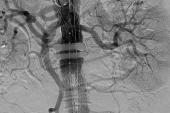People Age 90-Plus Do Fine With EVAR
Age alone should not determine suitability for endovascular repair of abdominal aortic aneurysm, experts say.

Abdominal aortic aneurysm (AAA) patients who are 90 or older fare just as well as their younger counterparts after endovascular aneurysm repair (EVAR), a study shows.
After accounting for differences in comorbidity burden and other factors with propensity-score matching, 30-day mortality and major adverse event rates did not significantly differ between nonagenarians and patients from other age groups, lead author Carlota Fernandez Prendes, MD (Ludwig-Maximilians-University Hospital, Munich, Germany), and colleagues report.
The findings, published in the April 20, 2021, issue of the Journal of the American College of Cardiology, were consistent in patients with either intact or ruptured aneurysms.
“Just using age as a [criterion] for intact and for ruptured aneurysms should not exclude patients from receiving treatment” with EVAR, Prendes told TCTMD. Instead, she and her co-authors recommend “tailored indications and carefully balanced risk assessment” to select patients for the procedure.
Agreeing was Gilbert Tang, MD, who wrote an accompanying editorial with Rami Tadros, MD (both Mount Sinai Hospital, New York, NY).
“Age should not be the only factor to [consider in] denying someone from EVAR,” he commented to TCTMD. Rather, it’s best to use a “patient-centered approach with imaging evaluation to discuss the risks and benefits of that particular patient that you see would be the most fruitful to gauge whether the patient would be a suitable candidate for EVAR.” And it might be a good idea, he added, to refer patients with complex anatomy to more-experienced, high-volume centers capable of delivering advanced interventions like branched or fenestrated EVAR.
EVAR in an Aging Population
The prevalence of AAA, and related mortality, increase steadily with age, and with a world population that is getting older, EVAR is being increasingly performed in patients in their 80s and 90s. A prior meta-analysis showed that octogenarians undergoing EVAR had higher 30-day mortality but similar midterm outcomes compared with younger patients, “suggesting that EVAR is indeed an appropriate therapeutic approach in this group of patients,” Prendes et al write.
Yet there is limited evidence regarding EVAR in nonagenarians. A 2015 systematic review showed a 30-day mortality rate of 4% and 22% perioperative complication rate in patients who were age 90-plus, with the authors concluding that the procedure has acceptable postoperative results in this group.
This new study helps fill the data gap by digging into the American College of Surgeons National Surgical Quality Improvement Program database. The analysis included 12,267 patients (mean age 73.8 years; 81.1% men) who underwent EVAR between 2011 and 2017, including 365 patients who were 90 or older at the time of the procedure.
The proportion of patients with ruptured AAA was higher in the oldest age group (15.7% vs 6.5%), as was the mean aneurysm diameter (6.5 vs 5.8 cm; P < 0.001 for both).
Before any adjustment, 30-day mortality was higher in nonagenarians (9.9% vs 2.2%; P < 0.001), and multivariate analysis revealed that age 90-plus was independently associated with death (OR 3.36; 95% CI 2.19-5.15).
After accounting for baseline differences between nonagenarians and younger patients with propensity matching, however, there were no significant differences in 30-day mortality for those with intact AAA (5.3% vs 3.0%; P = 0.15) or ruptured AAA (38.0% vs 28.6%; P = 0.32). There were also no differences in rates of 30-day major adverse events, a composite of cardiac arrest, MI, stroke/other cerebrovascular events, pneumonia, pulmonary embolism, unplanned intubation, sepsis/septic shock, acute renal failure, and organ/space or deep incisional surgical site infections.
Rates of reintervention, readmission, acute conversion to open surgery, 30-day postoperative aneurysm rupture, lower-extremity ischemia requiring intervention, or ischemic colitis after elective repair did not differ by age either.
Prendes et al note that the comparable outcomes “could be secondary to a ‘favorable’ physician selection of patients ≥ 90 years, with the use of stricter criteria (skewed toward selecting the ‘best’ ≥ 90-year-olds for treatment) than when considering intervention in patients aged 60 to 79 or 80 to 89 years.” Nonetheless, they say, the findings indicate “that AAA nonagenarian patients with similar comorbidities (albeit these may be the fittest 90-year-olds) do not do worse than younger patients, suggesting that age ≥ 90 years should not exclude patients from undergoing EVAR.”
Careful Patient Selection Key
Although age 90-plus was independently associated with mortality, Prendes pointed out that several other factors more strongly correlated with poor outcomes. That includes functional status and preoperative ventilator or dialysis dependency.
“In any case, an individual evaluation based on the patient’s baseline demographics, ambulatory independence, and AAA size should probably be the guide to determining the best strategy for AAA management in nonagenarians,” the investigators advise.
In their editorial, Tang and Tadros also highlight the importance of careful patient selection to achieve good EVAR outcomes, and they provide a table laying out specific criteria to consider in nonagenarians. It includes guideline-recommended AAA diameters that should prompt consideration of an intervention and underscores that patients should not have prohibitive comorbidities or major organ dysfunction, should have high functioning capacity, and should have favorable AAA anatomy.
Importantly, Tang and Tadros say, the “risk of elective EVAR should be lower than risk of aortic rupture.”
Tang said the points raised in the table could apply to any patient considered a candidate for EVAR, but a cautious approach is particularly important in the oldest group. “We strongly feel that a comprehensive multidisciplinary evaluation is really necessary on these patients because the stakes are so high,” he said. “Getting them through the operation means that you have to be very meticulous about your evaluation and discussion with the family about the procedural risks for that particular patient.”
Todd Neale is the Associate News Editor for TCTMD and a Senior Medical Journalist. He got his start in journalism at …
Read Full BioSources
Prendes CF, Dayama A, Panneton JM, et al. Endovascular aortic repair in nonagenarian patients. __J Am Coll Cardiol_. 2021;77:1891-1899.
Tang GHL, Tadros RO. Endovascular aortic repair in nonagenarians: select well and time appropriately. J Am Coll Cardiol. 2021;77:1900-1902.
Disclosures
- Prendes and Tang report no relevant conflicts of interest.
- Tadros reports having received honoraria from Abbott, Cook, Gore, and Medtronic for educational events.





Comments